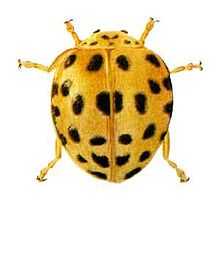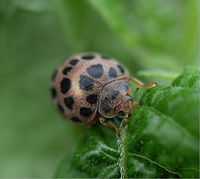Henosepilachna vigintioctopunctata
| Henosepilachna vigintioctopunctata | |
|---|---|
 | |
| Scientific classification | |
| Kingdom: | Animalia |
| Phylum: | Arthropoda |
| Class: | Insecta |
| Order: | Coleoptera |
| Family: | Coccinellidae |
| Genus: | Henosepilachna |
| Species: | H. vigintioctopunctata |
| Binomial name | |
| Henosepilachna vigintioctopunctata (Fabricius, 1775) | |
| Synonyms | |
|
Epilachna vigintioctopunctata | |
Henosepilachna vigintioctopunctata is a species of beetle in the family Coccinellidae. It is commonly known as the 28-spotted potato ladybird[1] or the Hadda beetle.[2] It feeds on the foliage of potatoes and other solanaceous crops. It originated in the far east of Russia. It was previously called Epilachna vigintioctopunctata and is a cryptic species complex.[3]
Morphology and biology

The body of the 28-spotted potato ladybird is nearly round, convex, glossy and up to seven millimetres long. It is reddish-brown with thirteen black spots on each elytron and one or more on each side of the thorax. The eggs are yellow, about 1.5 millimetres long and are placed on the undersides of leaves in batches of ten to sixty five eggs. The oval larvae and pupae are yellow-green decorated with black branched thorny appendices. The beetles and larvae live openly on the leaves, eating the soft tissues between the veins. The female ladybird may produce 300 to 400 eggs. The development stages are completed in four to six weeks under optimal conditions. The larvae pupate on the leaves and young beetles of the new generation feed intensively for one to two weeks to build up their fatty tissue. Only adults are capable of over-wintering. They usually hibernate under fallen leaves at the edges of woods, in bushes or under plant residues in fields.[4]
Distribution
This species originated in the far east of Russia and has been expanding its range in the second half of the 20th century and is now found over most of Russia, north-east China, northern Korea and Japan.[4] It is also found in Australia.[5]
On 1 February 2010 it was reported that an entomologist had identified the presence of Hadda beetles in the Auckland area of New Zealand.[6] MAF Biosecurity New Zealand introduced a surveillance and eradication programme but on March 25, 2010 announced that eradication was impracticable and that they would work with the horticulture industry to minimise the impact of this new pest.[7]
Economic significance
This species causes damage to agricultural crops in the three families Solanaceae (potato, tomato, aubergine and pepper), Cucurbitaceae (cucumber, melon, water-melon and pumpkin) and Fabaceae (soya and haricot beans). However the optimal host plant for the reproduction of over-wintered beetles and the development of their larvae is the potato. The loss in yield of potato tubers may reach 25% in heavy infestations. Control is by the use of resistant varieties of plants, crop rotation, the growing of solanaceous crops in open windy locations, the destruction of all plant residues and the use of pesticides when necessary.[4]
References
- ↑ "Henosepilachna vigintioctopunctata (Fabricius)". CSIRO. July 7, 2005. Retrieved April 27, 2009.
- ↑ "Hadda Beetle". Ministry of Agriculture and Forestry (New Zealand). February 12, 2010. Retrieved March 31, 2010.
- ↑ Haruo Katakura (September 20, 1997). "Species of Epilachna ladybird beetles". BioOne. Retrieved April 6, 2010.
- ↑ 4.0 4.1 4.2 AgroAtlas
- ↑ OzAnimals
- ↑ Hadda Beetle find in Auckland Retrieved December 4, 2010.
- ↑ Hadda beetle established in Auckland Retrieved December 4, 2010.
External links
 Data related to Epilachna vigintioctopunctata at Wikispecies
Data related to Epilachna vigintioctopunctata at Wikispecies Media related to Henospilachna vigintioctopunctata at Wikimedia Commons
Media related to Henospilachna vigintioctopunctata at Wikimedia Commons- Brisbane Insects
- The Epilachna vigintioctopunctata Complex